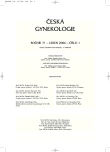Breast Cancer Cell Populations and its Changes Relation to Therapy
Authors:
D. Kolařík 1; I. Netíková 2; I. Marinov 3; I. Juliš 4; M. Halaška jr. 5; K. Rauš 1; D. Driák 1; J. Záhumenský 1; K. Benková 6; M. Halaška 1
Authors‘ workplace:
Gynekologicko-porodnická klinika 1. LF UK a FN na Bulovce, Praha, přednosta prof. MUDr. M. Halaška
DrSc.
1; Onkologická klinika 1. LF UK a VFN, Praha, přednosta doc. MUDr. L. Petruželka, CSc.
2; ÚHKT, Praha, přednosta prof. MUDr. P. Klener, DrSc.
3; Biolab s. r. o., Praha
4; Gynekologicko-porodnická klinika 2. LF UK a FN Motol, Praha, přednosta doc. MUDr. L. Rob, CSc.
5; Ústav patol. a soud. lékařství, FN na Bulovce, Praha, prim. MUDr. K. Benková
6
Published in:
Ceska Gynekol 2006; 71(1): 43-60
Category:
Original Article
Overview
This review summarizes the data from published studies that dealt with observation of various bioparameters changes in cancer population dependant on used therapy. Critically evaluating these studies and looking for relations among separate results we are trying to estimate prognostic value of these parameters (likelihood of recurrence, overall survival, ...) and also their value for prediction of tumor response to cytostatic, hormonal or other treatment. The aim is selection of such tumor population characteristics the testing of them would enable better patient stratification in postoperative adjuvant systemic therapy.
Key words:
breast cancer, chemotherapy, cellular changes, hormonal therapy
Labels
Paediatric gynaecology Gynaecology and obstetrics Reproduction medicineArticle was published in
Czech Gynaecology

2006 Issue 1
Most read in this issue
- Prematurity and Methods of its Screening
- Intraductal Papillary Proliferation of Brest. Actual Review and Clinicopathological Corelation
- Ovulatory Mucus and his pH, Arborization and Spermagglutination Antibodies in Women with Fertility Disorders
- Enucleation of Intramural Uterine Fibroids in Women at Fertile Age: Midterm Results of Prospective Clinical Trials
